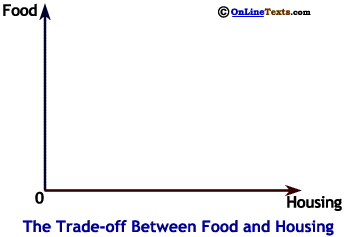

18 It's hard to drive a nail with a cookie sheet, and while it may be fun to cut a cake with a chain saw, it's not a good idea.
 The graph to the right shows a PPF illustrating another set of trade-offs, this time the trade-off is between Food and Housing for some country. Similar trade-offs would be faced by any society or country. Every point along the PPF represents combinations of Food and Housing that can be produced by this country if it uses all its resources fully and efficiently in production. The opportunity cost of food in terms of housing, or vice versa, depends on current production levels. Our reasoning is the same as before. Some resources are better suited for food production, and others are better suited for constructing housing. For instance, some people are better cooks than builders, and some land is better for growing corn than trees.18
The graph to the right shows a PPF illustrating another set of trade-offs, this time the trade-off is between Food and Housing for some country. Similar trade-offs would be faced by any society or country. Every point along the PPF represents combinations of Food and Housing that can be produced by this country if it uses all its resources fully and efficiently in production. The opportunity cost of food in terms of housing, or vice versa, depends on current production levels. Our reasoning is the same as before. Some resources are better suited for food production, and others are better suited for constructing housing. For instance, some people are better cooks than builders, and some land is better for growing corn than trees.18
If this society uses all its resources providing housing, it will be able to produce 150 units. If it chooses to produce some food, it can move to point A. It only needs to give up 10 units of housing, reducing housing output from 150 to 140, while food production increases from 0 to 40 units. The opportunity cost of food in terms of housing is very low when all the resources are used for housing production, because some people who are good cooks but lousy builders are nevertheless building, and some land that is ideal for corn or wheat but poor for lumber is still being used to grow trees. If it decides to produce food, the society will first move those resources most suited to food production from housing production, so the loss in housing output will be small but the increase in food output will be large.


18 It's hard to drive a nail with a cookie sheet, and while it may be fun to cut a cake with a chain saw, it's not a good idea.